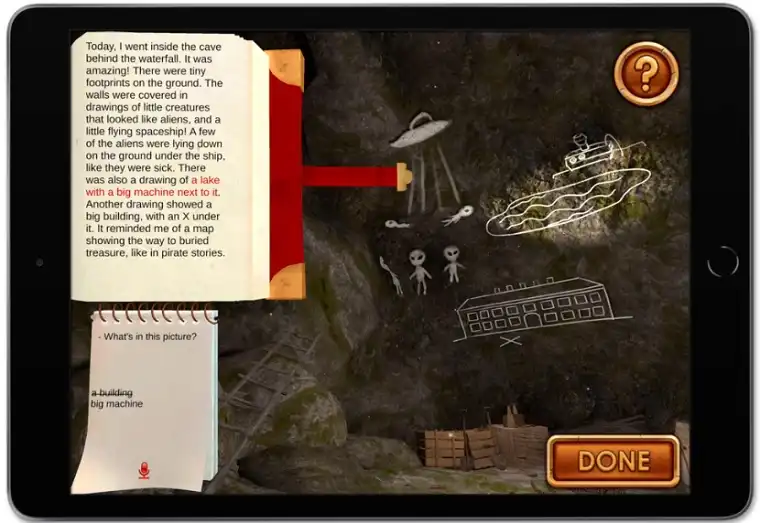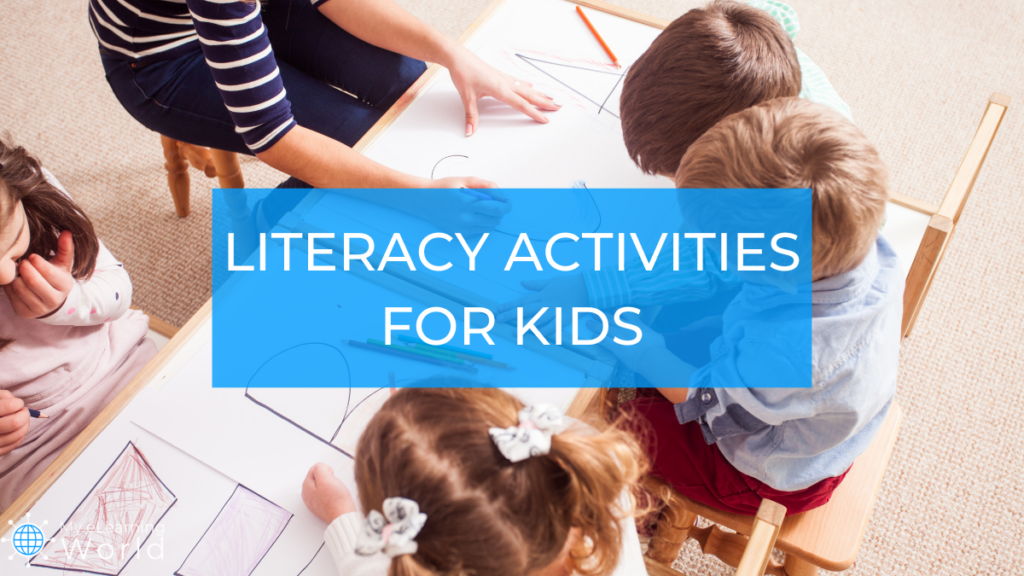Learning to read is a huge milestone for any student, and with the fun and engaging literacy activities for kids that we’re going to share in this post, that milestone can be achieved faster and more effectively.
Learning to love reading – and actually take away meaning from a text – is even more important.
To make sure that our kids really comprehend and enjoy what they’re reading, we have to help them build a strong foundation of literacy.
Literacy refers to how a learner thinks about reading and writing. It encompasses all of the strategies a reader uses when they approach the written word.
Activities that build literacy help young learners decode new words, read with better speed and accuracy, and access the deeper meaning of texts they’ve read.
When we expose our kids to more literacy activities, we’re essentially putting more tools in their reading toolbox.
Like any craftsman will tell you, having the right tools handy is necessary for getting the job done well and enjoying the process.
In this article, we delve into some fun and easy literacy activities that you can adapt for your own young readers.
These literacy activities are perfect for strengthening reading skills during the summer, but can also be incorporated into your after-school routine too.
Read on to check out these ideas for helping your child achieve all of their reading goals!
Disclosure: Some of the links in this article are affiliate links, meaning at no additional cost for you, we might get a commission if you click the link and purchase.
5 Great Literacy Activities for Kids
1. Talk it Out with Book Talks
It may seem obvious, but making time to talk about books is a highly effective way to boost your child’s literacy skills.
Carving out a specific time (say, twenty minutes) for your child to read every day is a great way to make sure that both reading and book talks actually take place.
It might be the first thing your child does after breakfast or the last thing before lights-out, but having an established routine goes a long way towards lifting literacy.
Keep in mind that your book talks don’t have to be long and formal. Just having your child tell what happened in the story that day is excellent practice.
The ability to summarize a reading passage is a huge component of literacy. Plus, it’s an easy way for you to check that your reader is actually understanding their book.
Remind your child to pay attention to pictures, diagrams, and chapter headings as they summarize. Sometimes these features provide clues about what’s happening in the story.
Don’t be afraid to reread, either. Going back to a page or reading the whole text again is a great way for your reader to understand their book more deeply.
Your book talks don’t have to only be based on summarizing. Have your child compare characters, predict what happens next, or tell their favorite and least favorite parts of the plot so far.
Taking the time to verbally retell and review a story builds your child’s comprehension, recall, and attention span.
Book talks also help young learners see reading as an interesting subject, one even grownups think is worth discussing.
2. Get Creative When a Book is Finished
Finished with a story? Bring out your child’s silly side by having them come up with a creative way to share their reading achievement.
Ask your child to create a Tiktok-style dance that retells the plot (even if you don’t actually post it to any social media platform).
Make sure they include the rising action, climax, falling action, and resolution… and don’t forget the music!
You can also have your child come up with a commercial selling the book to who they think might like it.
Remind them to explain why they think certain readers might enjoy it – or why not.
Encourage your child to “invite” one of the characters over and create an itinerary for the day.
What would that character want to do or eat? What would they plan to make sure the character had fun? Why?
More advanced readers might even enjoy writing a sequel to a book they’ve finished.
Will everything remain happily ever after, or will the villain make a surprise return? Let your child decide as they extend the story with an extra chapter or two.
The purpose of these activities is to help your child make meaningful connections to the story by bringing it to life, instead of shutting the book and forgetting all about it.
Plus, these literacy builders are sure to have you both laughing along the way!
3. Add in Some Apps
Not all meaningful reading needs to come from an ink-and-paper book. Instead, let your child mix things up by exploring a fun literacy app.
An excellent (and completely free!) option for elementary schoolers is Lou Adventures, offered at no charge on mobile app stores.
The reading program app builds literacy by having learners follow Lou, a friendly talking Labrador, as they uncover a mystery through reading passages.
Lou Adventures uses voice-recognition recording technology to monitor kids’ fluency and accuracy as they read each page out loud.
Reading aloud is a great way for kids to build confidence. Plus, parents can listen back to their kids’ recordings to identify their strengths and weaknesses.
After reading each section aloud, kids answer comprehension questions that help them find clues needed to solve Lou’s mystery.
One of the helpful features included in the Lou Adventures app are the built-in scaffolds designed to support independent reading.
For example, if a child is struggling to get through the reading passage, they can listen to Lou read it out loud instead.
If a child isn’t able to get the comprehension questions correct, Lou will highlight where in the story they can go back and look for the right answer.
Supports like these foster good reading habits while keeping reluctant readers from getting discouraged.
The app also lets kids unlock literacy-building games aimed at using new strategies to understand the text.
One game has readers matching synonyms for new vocabulary words, while another encourages them to use the new words in a sentence.
These games are much more effective than simply providing the definitions of the words, since they tap into your child’s critical thinking and reasoning abilities.
Gameplay also keeps Lou Adventures entertaining enough not to feel like schoolwork.
Plus, the app offers a Parent Dashboard with your child’s read-alouds and question results, so you can monitor progress without lingering over their shoulder.
Adding in fun apps like Lou Adventures keeps your child’s routine fresh and exciting, which will help them stay motivated to keep reading.
Take a look at our Lou Adventures review for more details or click here to try it for free.
 Lou Adventures: An Interactive Learning Story for Kids
Lou Adventures: An Interactive Learning Story for Kids
Lou Adventures is an interactive learning story for kids that helps them improve their reading skills through a fun, adventurous game.
4. Explore Old-School Games
While digital apps like Lou Adventures may be more current, there are plenty of more old-fashioned games out there that also boost literacy.
Classics like Scrabble, Bananagams, and Boggle are fun ways to grow your child’s decoding and word-building skills.
These games keep young learners entertained while encouraging them to sound out words and recognize spelling patterns.
Playing literacy-related games with friends and family can be so much fun that your youngster won’t even realize they’re becoming a stronger reader and thinker!
You can also have your child create an original game after finishing a book.
Simple supplies like cardboard, paper, and crayons are all your reader needs to come up with a fun reading game of their own.
Whether it’s a complex journey with multiple characters or a simple word search, giving your child a chance to be the game creator will help put their literacy skills into practice!
5. Read With a Buddy
Another way to prevent reading time from feeling dull is to read with a partner.
This might mean that you and your child read together, taking turns with each page or paragraph (depending on your child’s reading level).
Encourage kids to read with their own friends, too. Younger learners usually love sitting side by side with a pal, sharing the same story.
Older kids, meanwhile, might want to have their own copies of the same book to read while they hang out together.
Aside from being more fun, having your child read with a peer will encourage them to pay closer attention to the text so that they can share their thoughts with each other.
Kids can also get help from one another with parts of the story they didn’t understand, and provide each other with different perspectives and insights.
Just make sure that both buddies are on a similar reading level so that one child isn’t struggling to keep up.
When it comes to buddy reading, don’t let geography limit you, either… with so many mobile connection apps, the sky’s the limit as to who your child can read with!
A virtual reading session with a faraway relative or family friend can be a special way to bond while strengthening literacy at the same time.
A Final Word on Literacy Activities for Kids
Remember, a love of reading is a gift that will serve your child for a lifetime.
Strong readers will be more confident and successful in every academic area. They’ll also be able to discover new worlds of knowledge and fantasy in the pages of a book.
Jump into the literacy activities listed above to start building your child’s skills, and watch their love of reading take off.
We’d love to hear your ideas for helping kids love reading! Feel free to share other great literacy activities for kids in the comments below.


